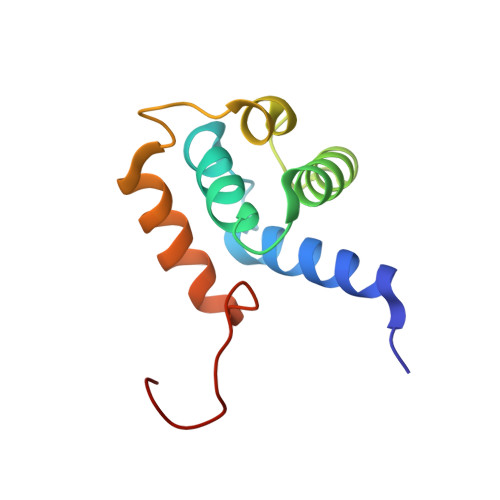Inaugural structure from the DUF3349 superfamily of proteins, Mycobacterium tuberculosis Rv0543c.
Buchko, G.W., Phan, I., Myler, P.J., Terwilliger, T.C., Kim, C.Y.(2011) Arch Biochem Biophys 506: 150-156
- PubMed: 21144816
- DOI: https://doi.org/10.1016/j.abb.2010.12.001
- Primary Citation of Related Structures:
2KVC - PubMed Abstract:
The first structure for a member of the DUF3349 (PF11829) family of proteins, Rv0543c from Mycobacterium tuberculosis, has been determined using NMR-based methods and some of its biophysical properties characterized. Rv0543c is a 100 residue, 11.3 kDa protein that both size exclusion chromatography and NMR spectroscopy show to be a monomer in solution. The structure of the protein consists of a bundle of five α-helices, α1 (M1-Y16), α2 (P21-C33), α3 (S37-G52), α4 (G58-H65) and α5 (S72-G87), held together by a largely conserved group of hydrophobic amino acid side chains. Heteronuclear steady-state {¹H}-¹⁵N NOE, T₁, and T₂ values are similar through-out the sequence indicating that the backbones of the five helices are in a single motional regime. The thermal stability of Rv0543c, characterized by circular dichroism spectroscopy, indicates that Rv0543c irreversibly unfolds upon heating with an estimated melting temperature of 62.5 °C. While the biological function of Rv0543c is still unknown, the presence of DUF3349 proteins predominantly in Mycobacterium and Rhodococcus bacterial species suggests that Rv0543 may have a biological function unique to these bacteria, and consequently, may prove to be an attractive drug target to combat tuberculosis.
- Biological Sciences Division and Seattle Structural Genomics Center for Infectious Disease, Pacific Northwest National Laboratory, Richland, WA 99352, USA. garry.buchko@pnl.gov
Organizational Affiliation:
















